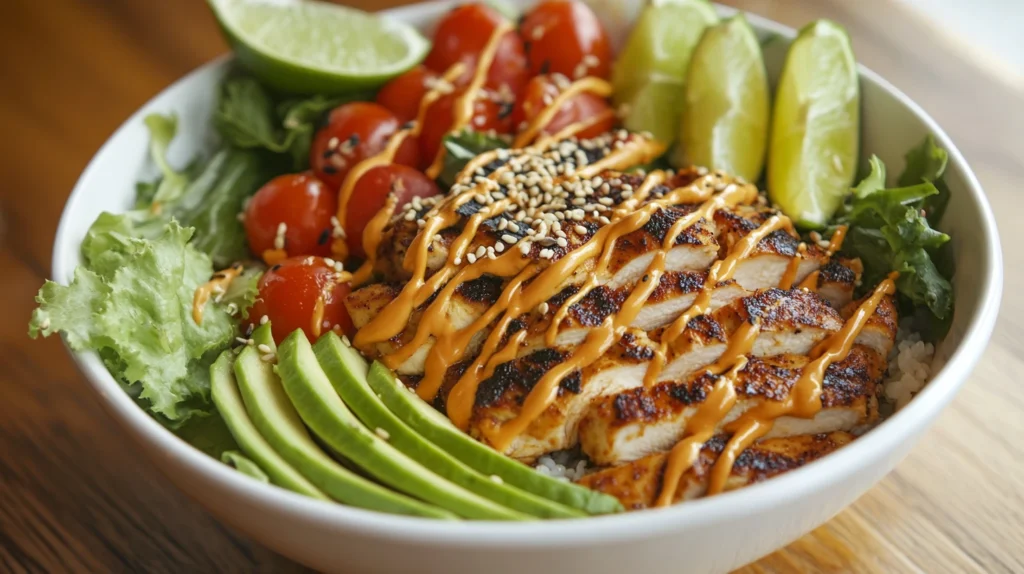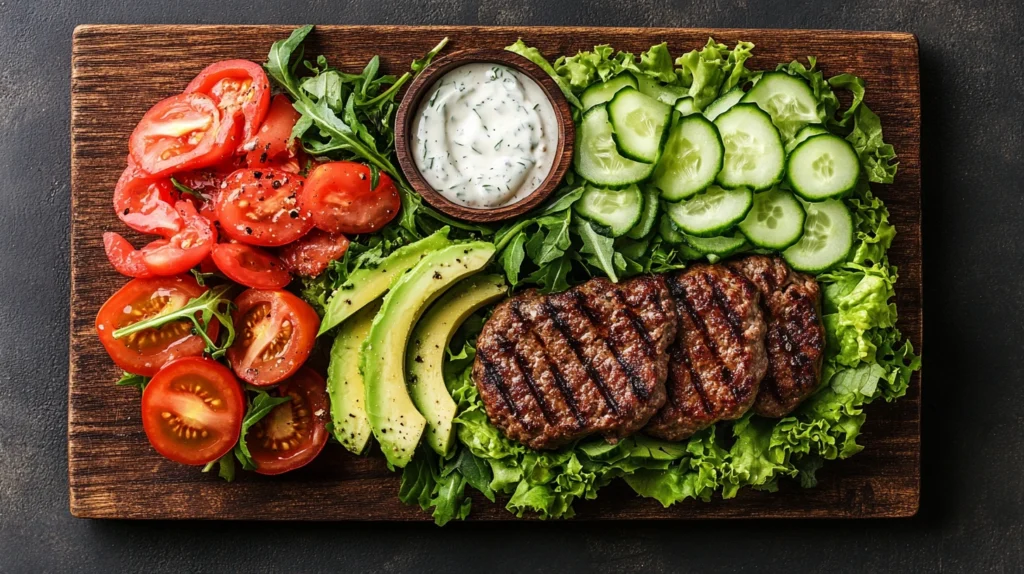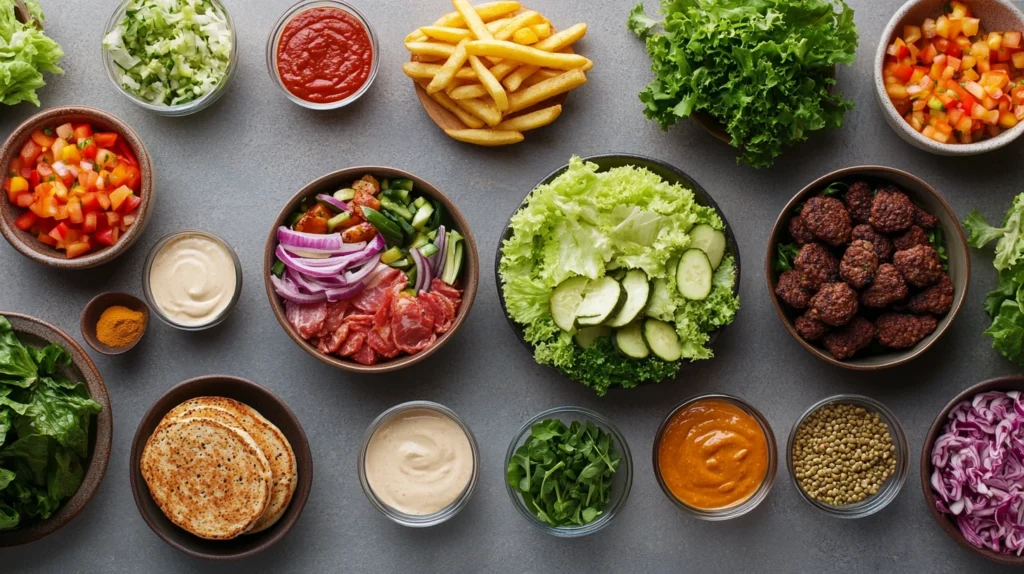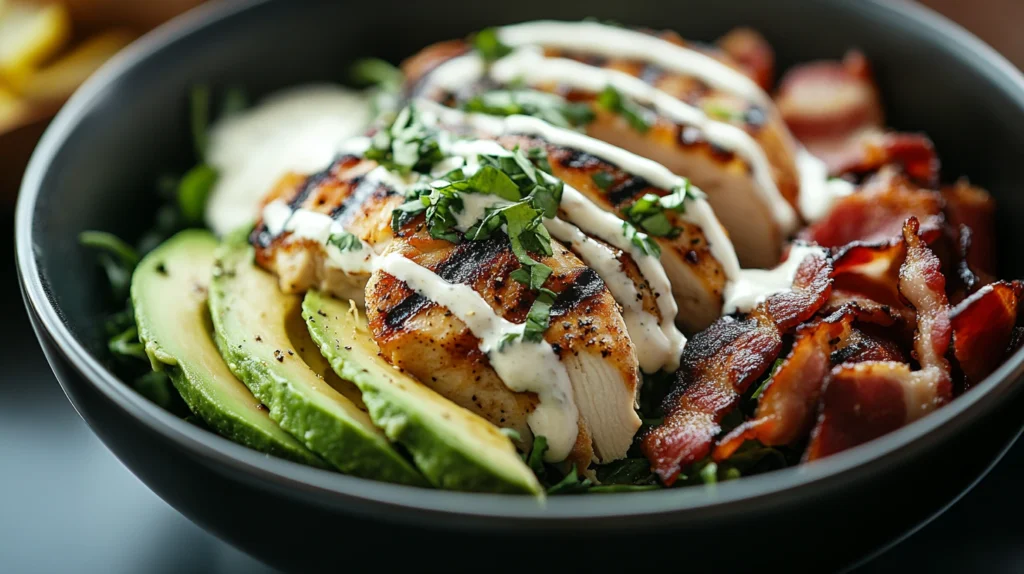
Burger bowls have taken the food world by storm—and for good reason! They combine the best parts of a burger, like juicy patties, melted cheese, and crunchy toppings, without the carb-loaded bun. But the big question is: How many calories are in burger bowls? 🤔
Well, it depends! The calorie count varies based on the ingredients you use—protein, veggies, sauces, and even toppings can make a big difference.
In this article, we’ll break it all down step-by-step. We’ll cover everything from calorie counts to healthier swaps, easy recipes, and tips for portion control. Ready? Let’s jump in! 🍔🥗
Table of contents
Nutritional Breakdown of Burger Bowls

Before we get into the specifics, let’s lay the groundwork. Burger bowls are typically loaded with protein, healthy fats, and fiber—making them a great option for people following low-carb, keto, or high-protein diets. But they can also sneak in some extra calories if you’re not careful.
So, what’s actually inside a burger bowl? Let’s start with the star of the show—the protein.
Calorie Count Based on Ingredients
Proteins are the foundation of burger bowls, and the calorie count can vary widely based on what you choose. Here’s a quick breakdown:
| Protein Type | Serving Size (4 oz) | Calories | Protein (g) | Fat (g) |
|---|---|---|---|---|
| Ground Beef (80/20) | 4 oz | 280 | 25 | 20 |
| Lean Ground Turkey | 4 oz | 170 | 22 | 8 |
| Grilled Chicken | 4 oz | 165 | 35 | 4 |
| Plant-Based Patty | 4 oz | 200-250 | 18-20 | 10-15 |
“Protein is the heart of any burger bowl, so picking a leaner cut can help keep calories in check without sacrificing flavor.” 🍗
Protein Content in Burger Bowls
Protein isn’t just important for building muscle—it’s also great for keeping you full and satisfied. Most burger bowls contain 25–40 grams of protein depending on the type of meat.
For example:
- Beef patties pack around 25 grams of protein per 4 ounces but come with higher fat content.
- Chicken breast offers a leaner, high-protein option with 35 grams of protein per serving.
- Plant-based patties have a decent protein count, ranging from 18–20 grams, perfect for vegetarians and vegans.
💡 Pro Tip: Add a boiled egg or sprinkle some cheese for extra protein without adding too many calories! 🥚🧀
Carbohydrate and Fiber Content
Unlike traditional burgers that come with calorie-packed buns, burger bowls are low in carbs—especially when loaded with leafy greens and veggies.
Here’s a quick look at some popular veggie options:
| Vegetable | Serving Size (1 cup) | Calories | Carbs (g) | Fiber (g) |
|---|---|---|---|---|
| Lettuce | 1 cup | 5 | 1 | 0.5 |
| Spinach | 1 cup | 7 | 1 | 0.7 |
| Cucumbers | 1 cup | 16 | 4 | 0.5 |
| Tomatoes | 1 medium | 22 | 5 | 1.5 |
“Adding fiber-rich veggies not only keeps your calorie count low but also helps you feel fuller for longer!” 🥗
Fats and Cholesterol Levels
Let’s talk fats—because not all fats are bad! Burger bowls often include healthy fats from avocados, olive oil, and nuts, but they can also sneak in saturated fats from cheese, bacon, and mayonnaise.
Fat Breakdown in Popular Ingredients:
- Avocado (1/2): ~120 calories, 10g healthy fats 🥑
- Cheddar Cheese (1 slice): ~70 calories, 6g fat 🧀
- Bacon (2 strips): ~90 calories, 7g fat 🥓
“Balance is key—healthy fats can boost flavor and nutrition, but keep an eye on portions to avoid calorie overload.” 🔍
Common Ingredients in Burger Bowls and Their Caloric Values
Types of Proteins: Beef, Chicken, Turkey, and Plant-Based Options
Your protein choice can set the tone for your entire meal. Here’s how different options stack up:
| Protein | Serving Size | Calories | Protein (g) | Fat (g) |
|---|---|---|---|---|
| Beef Patty (80/20) | 4 oz | 280 | 25 | 20 |
| Chicken Breast | 4 oz | 165 | 35 | 4 |
| Ground Turkey | 4 oz | 170 | 22 | 8 |
| Veggie Patty | 4 oz | 200-250 | 18-20 | 10-15 |
“Choosing the right protein isn’t just about calories—it’s about balance. Lean options can save calories without losing protein.”
Vegetables and Greens for Low-Calorie Additions
Greens are the backbone of a healthy burger bowl. They’re low in calories, high in nutrients, and add a satisfying crunch.
Popular choices include:
- Lettuce (1 cup): 5 calories
- Spinach (1 cup): 7 calories
- Arugula (1 cup): 5 calories
- Kale (1 cup): 33 calories
“Vegetables don’t just add nutrients—they make your bowl look vibrant and colorful!” 🌈
Customizing Burger Bowls for Low-Calorie Diets
Burger bowls are as flexible as your taste buds allow! Whether you’re counting calories, following a keto plan, or just trying to eat healthier, there are endless ways to make burger bowls fit your diet. Let’s explore how to keep those calories in check without sacrificing flavor. 🍔🥗

Substituting High-Calorie Ingredients
Sometimes, it’s not about what you add—it’s about what you replace. Swapping out high-calorie ingredients for healthier alternatives can cut down calories and boost nutrition.
Smart Substitutions:
- Beef → Ground Turkey or Chicken: Save up to 100 calories per serving by choosing leaner proteins. 🐔
- Cheese → Nutritional Yeast or Feta: Cut calories and fat while keeping the flavor intact.
- Mayonnaise → Greek Yogurt or Hummus: Creamy and flavorful with fewer calories and added protein.
- Croutons → Toasted Seeds or Nuts: Add crunch without the carbs.
| Ingredient | Calories (Standard Serving) | Low-Calorie Alternative | Calories |
|---|---|---|---|
| Ground Beef (80/20) | 280 | Ground Turkey (93% Lean) | 170 |
| Cheddar Cheese (1 slice) | 70 | Feta Cheese (1 oz) | 50 |
| Ranch Dressing (1 tbsp) | 70 | Greek Yogurt Ranch (1 tbsp) | 20 |
| Mayonnaise (1 tbsp) | 94 | Hummus (1 tbsp) | 25 |
“Think of your bowl as a blank canvas—small swaps can create a masterpiece without overloading calories.” 🎨
Portion Control Tips to Reduce Calories
Even healthy foods can add up quickly if portions aren’t kept in check. Here’s how to make sure you’re not accidentally eating too much:
- Use Smaller Plates or Bowls: This optical illusion makes you feel like you’re eating more than you actually are.
- Measure Ingredients: Don’t eyeball it—use measuring cups or a food scale for accuracy. ⚖️
- Fill Half the Bowl with Greens: Veggies like spinach, kale, and lettuce are low in calories but high in volume, so they make your bowl look full. 🥗
- Limit High-Calorie Add-Ons: Cheese, avocado, and sauces are delicious, but they’re calorie-dense. Use them sparingly.
“Portion control isn’t about eating less—it’s about eating smarter.” 💡
Low-Calorie Dressings and Sauce Alternatives
Let’s be honest—dressings can make or break your bowl. But many sauces are sneaky calorie bombs. Here’s how to keep flavor high and calories low:
| Sauce/Dressing | Calories (1 tbsp) | Fat (g) | Sugar (g) |
|---|---|---|---|
| Greek Yogurt Ranch | 20 | 1.5 | 1 |
| Balsamic Vinaigrette | 35 | 2.5 | 3 |
| Salsa (Mild or Spicy) | 10 | 0 | 2 |
| Dijon Mustard | 10 | 0.5 | 0 |
| Light Guacamole | 25 | 2.5 | 1 |
Quick Tip: Spice things up with fresh herbs, lemon juice, or hot sauce instead of drowning your bowl in dressings. 🌿🍋
“Sometimes the simplest flavors are the most satisfying—don’t be afraid to let fresh ingredients shine!” ✨
Popular Burger Bowl Recipes and Their Calorie Counts

Who said healthy can’t be delicious? Let’s explore some crowd-favorite burger bowl recipes and see how their calories stack up.
Classic Cheeseburger Bowl
Ingredients:
- 4 oz ground beef (80/20) – 280 calories
- 1 slice cheddar cheese – 70 calories
- 1 cup shredded lettuce – 5 calories
- 1/2 cup diced tomatoes – 15 calories
- 1/4 cup pickles – 10 calories
- 1 tbsp mustard – 10 calories
Total Calories: 390 calories
“This bowl captures all the flavors of a cheeseburger—no bun required!” 🍔
Low-Carb Keto Burger Bowl
Ingredients:
- 4 oz grilled chicken breast – 165 calories
- 1/4 avocado – 80 calories
- 2 slices bacon – 90 calories
- 1 cup spinach – 7 calories
- 1 tbsp ranch dressing – 70 calories
Total Calories: 412 calories
“Perfect for keto fans—high in protein and fats, but low in carbs!” 🥓
Vegetarian and Vegan Burger Bowls
Ingredients:
- 1 plant-based patty – 230 calories
- 1/2 cup quinoa – 111 calories
- 1 cup arugula – 10 calories
- 1/2 cup roasted chickpeas – 134 calories
- 1 tbsp tahini dressing – 45 calories
Total Calories: 530 calories
“Packed with plant-based protein, this bowl proves you don’t need meat to eat well!” 🌱
How to Calculate Calories in Homemade Burger Bowls
Making burger bowls at home means you’re in control of every ingredient—and every calorie. But how do you calculate the total count?
Step-by-Step Guide to Calorie Calculation
- Write Down Every Ingredient: List everything you’re using, from the meat to the toppings.
- Measure Portions Accurately: Use measuring cups, tablespoons, or a food scale.
- Check Labels or Use Apps: Tools like MyFitnessPal and Cronometer make it easy to log calories. 📱
- Add It All Up: Combine the totals to find the calorie count for your bowl.
Using Nutrition Apps and Tools
Apps can take the guesswork out of calorie counting. Popular tools include:
- MyFitnessPal: Tracks calories and macros.
- Cronometer: Provides detailed nutritional breakdowns.
- Lose It!: Focuses on portion control and goal-setting.
“Apps make calorie counting easier than ever—just scan, log, and eat!” ✅
Common Problems and Solutions When Making Burger Bowls
Even with the healthiest intentions, it’s easy to hit a few bumps when crafting the perfect burger bowl. Let’s address some common problems and quick fixes to keep your bowls tasty and low-calorie! 🥗
Problem 1 – High-Calorie Sauces and Dressings
The Issue:
Sauces and dressings are flavor-packed, but they often come with hidden sugars and fats that can skyrocket your calorie count.
The Solution:
- Switch to Low-Calorie Options: Opt for Greek yogurt-based dressings, vinaigrettes, or even fresh lemon juice. 🍋
- Measure Everything: Don’t eyeball it—stick to 1–2 tablespoons to stay within calorie limits.
- DIY Sauces: Blend herbs, Greek yogurt, and spices for a guilt-free dressing.
“Cutting calories doesn’t mean cutting flavor—just get creative with herbs, spices, and citrus!” 🌿
Problem 2 – Lack of Flavor Without Sauces
The Issue:
No one wants a bland burger bowl, but skipping sauces can sometimes make it taste…well, boring. 😕
The Solution:
- Spice It Up: Add garlic powder, cumin, paprika, or chili flakes to season your protein. 🌶️
- Use Vinegar and Citrus: A splash of balsamic vinegar or lime juice can transform any dish.
- Fresh Herbs Are Magic: Toss in cilantro, parsley, or basil for a burst of freshness. 🌿
“Spices are your secret weapon—they add flavor without piling on the calories!” ✨
Problem 3 – Overeating Due to Large Portions
The Issue:
Burger bowls are so delicious that it’s easy to go overboard and load your plate, even with healthy ingredients.
The Solution:
- Focus on Veggie Volume: Fill half your bowl with leafy greens to bulk it up without adding many calories. 🥬
- Pre-Portion Proteins and Fats: Measure your meat and toppings before adding them to the bowl.
- Mindful Eating: Slow down, chew thoroughly, and enjoy every bite—this helps you feel fuller faster.
“Portion control doesn’t mean deprivation—it’s about eating smarter, not less!” 💡
FAQs About Burger Bowl Calories
Let’s clear up some frequently asked questions about burger bowl calories and nutrition!
Are Burger Bowls Healthier Than Traditional Burgers?
Absolutely! Burger bowls ditch the bun, cutting out 150–200 calories and unnecessary carbs. Plus, they allow for more veggies and lean proteins, making them a balanced and nutrient-dense meal. 🥗
How Many Calories Are in a Fast-Food Burger Bowl?
Fast-food burger bowls can range from 500–800 calories depending on toppings and dressings. To keep calories low, skip creamy sauces, double up on veggies, and opt for grilled instead of fried proteins.
What Are the Healthiest Ingredients for Burger Bowls?
Stick to:
- Proteins: Grilled chicken, turkey, or plant-based patties. 🐔
- Veggies: Spinach, lettuce, cucumbers, tomatoes, and peppers. 🥒🍅
- Dressings: Light vinaigrettes, salsa, or Greek yogurt-based sauces.
Can Burger Bowls Help with Weight Loss?
Yes! Burger bowls are high in protein and fiber, which keep you full longer. Plus, they’re naturally low in carbs, making them ideal for weight loss and keto diets. 🔥
What Is the Average Calorie Count of a Burger Bowl?
Homemade burger bowls typically range from 300–600 calories depending on ingredients. For lower-calorie versions, choose lean meats, lots of greens, and light dressings.
Are There Gluten-Free Options for Burger Bowls?
Definitely! Most burger bowls are naturally gluten-free as long as you skip croutons and check sauces for hidden gluten. Perfect for gluten-sensitive eaters! 🌾🚫
Conclusion – Building the Perfect Burger Bowl for Any Diet
Burger bowls are more than just a trend—they’re a versatile, healthy, and customizable meal option that fits into nearly any diet plan. Whether you’re counting calories, following keto, or just trying to eat better, these bowls make it easy to stay on track without sacrificing flavor.
Key Takeaways:
- Use lean proteins like chicken or turkey to keep calories low.
- Pile on fiber-rich veggies for bulk without the calories. 🥗
- Replace heavy dressings with lighter alternatives like salsa or Greek yogurt.
- Track your calories using nutrition apps for accuracy. 📱
Burger bowls let you enjoy the best parts of a burger—without the guilt. So why not give them a try? You might just find your new favorite meal! 😋
Quick Nutrition Chart for Burger Bowls
| Ingredient | Serving Size | Calories | Protein (g) | Fat (g) | Carbs (g) |
|---|---|---|---|---|---|
| Ground Beef (80/20) | 4 oz | 280 | 25 | 20 | 0 |
| Ground Turkey (93% Lean) | 4 oz | 170 | 22 | 8 | 0 |
| Grilled Chicken Breast | 4 oz | 165 | 35 | 4 | 0 |
| Avocado | 1/2 medium | 120 | 2 | 10 | 6 |
| Spinach | 1 cup | 7 | 1 | 0 | 1 |
| Ranch Dressing (Light) | 1 tbsp | 20 | 1.5 | 2 | 0 |
Explore More Delicious Recipes and Healthy Meal Ideas
If you enjoyed learning about burger bowls and their calorie content, why stop here? We’ve got plenty more recipes and tips to keep your meals exciting, nutritious, and satisfying. Check out these related guides and recipes to take your cooking game to the next level! 🍳🥗
- Looking for More Protein Options? Explore our Comprehensive Beef Tips Guide to learn how to prepare tender, flavorful beef dishes perfect for any meal. 🥩
- Want More Meal Prep Inspiration? Discover the Differences, Uses, and Best Recipes for Stew Meat vs. Beef Tips to expand your meal options with easy, hearty recipes. 🍲
- Need Healthy Snacking Ideas? Check out our article on Rice Cakes Benefits and Recipes for low-calorie, nutritious snacks to complement your healthy lifestyle. 🍘
- Craving Comfort Food? Dive into the Ultimate Chicken Dumpling Soup Recipe for a warm, satisfying meal loaded with protein and flavor. 🍲🐓
No matter your dietary goals, we’ve got you covered with tips, tricks, and recipes that are as delicious as they are healthy. Keep exploring and enjoy your culinary adventures! 🌟
Final Thoughts:
Burger bowls offer endless possibilities. Whether you’re craving a classic cheeseburger flavor or a veggie-packed meal, there’s something for everyone. Plus, they’re easy to prep, perfect for meal planning, and can fit into almost any diet.
Now that you know how many calories are in burger bowls and how to customize them, what’s stopping you? Get creative and start building your perfect bowl today! 🍔🥗
